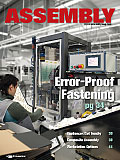
Make no mistake about it, error-proofing the fastening process continues to be extremely important for assemblers. The reason is simple: People make mistakes when installing fasteners.
The roots of error-proofing can be traced back to product-quality guru Edward Deming, says Tom Rougeux, sales manager of Design Tool Inc.
Deming introduced his principles of improving product quality and design to the United States in the 1940s, although they gained greater favor in Japan in the 1950s. A short time later, Shigeo Shingo made known the Japanese concept of poka-yoke (pronounced POH-kah YOH-kay), or mistake-proofing.
“Back then, fastening error-proofing in the U.S. was done by many inspectors on the production line,” says Michael Poth, director of marketing for Stanley Assembly Technologies. “Countless error-proofing improvements have been made since then to take the variables out of the fastening equation.”
Technological advancements in error-proofing began in the late 1970s, when Japanese assembly plants started using DC electric tools and pneumatic impulse wrenches in tandem with click wrenches. In the late 1980s, pneumatic assembly tools with torque transducers and angle encoders were introduced. In the late 1980s and early 1990s, power tools became available with an integrated controller that uses an electronic sensor to control torque.
Automation Determination
Automation is the ultimate form of error-proofing, because machines are far less likely to commit mistakes and will always tell the operator when they do make a mistake. The challenge for an assembler is determining whether the production process should or even can be automated.Several factors enter into the decision, including product design and complexity, volume, labor costs, quality, and hardware and software costs. If the assembler is a supplier to an OEM, their customer may specify whether the product should be assembled with manual, semiautomatic or fully automatic equipment.
“Automation might be necessary because the fasteners are too small to be manipulated by hand,” says Jan Aijkens, general manager for DEPRAG Inc. “Fasteners for things like cell phones and hearing aids are so tiny, a hand can’t efficiently handle and place them.”
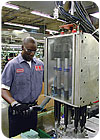
An operator uses this
fixtured tool system to perform fastening on a valve assembly. Photo courtesy
AIMCO.
Selecting Tools
Only after deciding on the process will an assembler turn its attention to tool selection and related error-proofing. “Our customers regularly ask us about error-proofing after they’ve decided on the tool they want,” says Brad Mountz, president of Mountz Inc.Today’s power tools, whether pneumatic or electric, feature sensors that enable assemblers to measure various aspects of fastening. Standard measurements include fastener presence, torque, angle, clamping force, run time window and batch count per product. Some sensors can even let operators know when a fastener has become stripped or cross-threaded.
“Tool selection is predicated more on repeatability than accuracy,” says Rougeux. For error-proofing purposes, he recommends assemblers assume a parameter of ±5 percent for air tools; about ±2 percent for electric tools, in general; and ±0.1 percent for DC tools, specifically.
Besides selecting the right tools and determining the fastening factors they want error-proofed, assemblers also must make sure their tools are calibrated correctly, says Greg Katsis, marketing manager of Sturtevant Richmont. He recommends assemblers keep a backup for each power tool. “The key is always being able to get the same error-proofing result,” says Katsis.
Some power tool suppliers, like Makita USA, offer error-proofing on a full line of cordless electric tools for increased operator maneuverability. These tools feature an on-board controller that determines fastening acceptance. The tools transmit their fastening data to a data interface via a wireless transceiver.
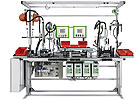
Error-proofing is enhanced
by implementing ergonomic assembly workstations, which can include
position-control stands, toolboxes, EC screwdrivers, man-machine interfaces for
each operator and part-marking systems. Photo courtesy DEPRAG Inc.
Fastener Factors
Sometimes fastening error is more related to the fastener than the tool. Two common problems are the dropping of fasteners and the inability of a fastener to be blowfed.The dropping of fasteners is not exclusive to manual fastening. “Consider the situation where a robot places a fastener into a location where the hole should be but isn’t,” says Rougeux. “The fastener will be knocked to the ground or into the product. Also, the fastener received might have been defective.”
A fastener’s dimensions might prohibit it from being blowfed to a robot or operator. “Some fasteners have unfavorable head-to-length ratios, which make them more difficult or impossible to blowfeed,” says Aijkens.
Minimizing the amount and variety of fasteners enhances error-proofing and is always the goal. But sometimes more or larger screws must be used to obtain the required clamping force. Assemblers also need to make sure that the tool reaches torque in a time frame proportional to fastener length.
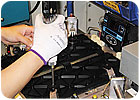
Assembling automotive
interior parts, this manufacturer uses a Scout Screw Counter to make sure all
fasteners are correctly installed. Once assembly is complete, the Scout sends a
signal via PLC to the quality control monitoring system. Photo courtesy Mountz
Inc.
Improving Workstation Design
Plant engineers can enhance error-proofing by designing operator-friendly fastening workstations and frequently conducting process audits. Operator-friendly stations might include some or all of the following features:Design for Automation. “The workstation should be designed like a piece of automation to maximize error-proofing,” says Aijkens. For example, DEPRAG recently designed a semiautomatic fastening workstation for a major automotive supplier in Germany. Equipped with integrated process sensing and controlling devices, the station served two operators who manually assembled circuit boards for navigation and sound systems into housings.
Color-Coded Tools and Bins.Color-coding tools was one of the first methods of error-proofing the fastening process. “The color indicated the tool was programmed to fasten to a specific torque,” says Mountz. “Color torque covers also prevented the operator from adjusting the torque.”
Color-coded tools allow the plant supervisor to see from a distance if the assembler is using the correct tool, notes Ken Maio, business development manager of AIMCO. If a worker is using a tool of the wrong color, it could mean the correct tool needs repair, or that an improperly set tool for the application has migrated to that workstation.
Color bins are another common practice. Photoelectric sensors on the bins interact with the station’s programmable logic controller (PLC), which will only allow the tool to be used if the operator has retrieved fasteners from the bins in the correct sequence.
Fastening Instructions. More and more, assemblers are placing fastening instructions in the workstations to limit operator error. These instructions may be as low-tech as laminated posters or notebooks, or as high-tech as touchscreens or video monitors.
“Rotating associates between workstations is a very common practice, so you don’t want to leave error-proofing to chance,” says Maio.
He explains how one plant, which made right and left rearview mirrors for General Motors, addressed this challenge. “Each station featured large photos that showed the worker how to hold and use the tool; how to install the fastener properly and to what torque; how long to wait until the tool turned itself off [and displayed] a green light; and even what to do if a red light comes on.”
Training is critical. Operators need to know the hows and whys of error-proofing efforts, and they need to know when to alert plant engineers of problems in the fastening process.
Ergonomics.Fatigue leads to mistakes. By improving ergonomics, assemblers can help error-proof their fastening stations. Assemblers should provide operators with lightweight, comfortable tools to lessen the chance of fatigue and carpal tunnel syndrome. A tool balancer or torque-control arm can absorb torque reaction and help operators position the tool.
“Be sure to order enough tool trolleys and tool balancers with a weight capacity that matches or exceeds the weight and quantity of the tools required at the work surface,” says Bob Simmons, senior vice president at Pro-Line, a workstation supplier.
Also, fastener bins should be positioned near the operator to reduce the physical strain of reaching and shorten cycle time.
Rework Diversion.Some assemblers choose to rework product having faulty fastening rather than scrap it. For maximum error-proofing, it’s imperative that the workstation be designed so that such product is kept completely separate from approved product.
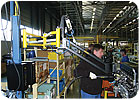
With encoders at every
joint, tool-positioning systems ensure that each screw has been installed in
the correct place in the correct sequence. Photo courtesy Stanley Assembly
Technologies.
Helpful Technologies
Controllers. For many years now, the most helpful technology for error-proofing a fastening station has been the PLC. In fully automated processes, the PLC controls all aspects of the fastening process. In manual and semiautomatic processes, each fastening tool is linked to the PLC via a tool controller.The tool controller and PLC continually communicate data to and from each other as each fastening task is performed, to error-proof the process. The PLC can be programmed to ensure the assembler uses the correct tool, as well as the correct amount of screws and types of screws.
When an operator correctly completes all fastening tasks, the man-machine interface (MMI) will indicate this visually, audibly or both, and the PLC will let the assembled product move to the next station for further assembly or final packaging.
The error-proofing capabilities of both PLCs and tool controllers continue to improve. “In the 1980s, when a fastening error occurred, the operator received computer information feedback like ‘Code 52,’ ” says Rougeux. “Today, the PLC provides specific information on the user-interface screen like, ‘Torque failed on screw three; rework and reattempt fasting.’ ”
Tool controllers can be programmed with more fastening parameters than ever, enabling a tool to automatically change torque and angle parameters after each fastening cycle, says Mountz. As a result, an operator can now use one tool instead of two to install two different fasteners, lessening the chance for errors.
Some assemblers integrate their tool controllers with the plant network to download build data and error-proof assembly of multiple products on one assembly line. “In an auto plant, tool controllers must know more than what kind of car has entered the workstation,” says Poth. “They also must know what option group is going to be on that car and all fastening requirements.”
Currently, a tool controller works with either a pneumatic or electric tool. However, Michigan Pneumatic is developing a microprocessor-based generic controller for both pneumatic and electric tools. The controller will offer comprehensive error-proofing, including a shut-off valve (pneumatic) and servo amplifier (electric) that disengage when torque is reached.
Tool Support Arms.A power tool is mounted on this arm, which attaches to the workstation. Encoders in the joints of the arm enable the operator to move the tool along the X-Y axes and install fasteners.
The error-proofing benefits of this arm are two-fold: It ensures that the operator uses the correct tool, and it ensures that the operator installs fasteners on a product in the right sequence.
However, power tool suppliers have mixed feelings about whether such an arm is a worthwhile investment. Some feel the money spent on the arm could be better used to fully automate an assembly process. Others feel the arm is valuable for its ergonomic benefits, because it lessens operator fatigue.
Screw Presenters. Assemblers sometimes receive screws that are either damaged or don’t meet dimensional specifications. To error-proof the screw presentation process, assemblers can ask their screw supplier to laser sort the screws before they’re shipped. Assemblers also can use an automatic screwfeeder so the right screw is presented to the operator or robot in the correct orientation.
“Smart” Tool Boxes With Multiple Screw Bits or Sockets.These tool boxes contain numerous bits and sockets, which are linked to the tool controller so the corresponding pre-stored fastening parameters and sequence will be used. This enabless the operator to assembles a variety of fasteners with one tool and socket.
Vision-Guided Robotic Screwdriving Systems. This technology is for fully automated processes that require precision fastening. It’s best suited for the medical and electronics industries because of their need for precision and sterile environments.
Visumatic recently installed a vision-guided robotic screwdriving system at an electronics assembly plant. The system is being used to install screws in big-screen TVs without scratching them.
“Our vision system verified part presence, identified its size and orientation, then fastened 17 to 23 screws within the required 45-second cycle time,” says Jarrod Neff, business development manager for Visumatic.
While vision-guided screwdriving robots represent cutting-edge technology, one of the simplest methods for error-proofing the fastening process is very low-tech indeed. Assembly managers simply need to keep their workforce focused. “Operators do get interrupted and lose track of where they are in the fastening process,” says Katsis. “Don’t let others distract you while you do your job.”
